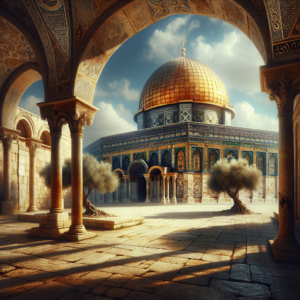“Harmony in Stone: Capturing Eternity in Temple Mount’s Architectural Majesty”
Introduction
“Harmony in Stone: The Timeless Allure of Temple Mount’s Architectural Wonders” explores the enduring beauty and significance of the architectural masterpieces located on Jerusalem’s Temple Mount. This historical plateau has been a focal point for religious devotion, political struggle, and scholarly intrigue for millennia. The book delves into the intricate designs, engineering feats, and symbolic meanings embedded within the ancient stones that comprise the Western Wall, the Dome of the Rock, and the Al-Aqsa Mosque. It examines how these structures have stood the test of time, bearing witness to the region’s tumultuous history while continuing to inspire awe and reverence in visitors from around the world. Through a detailed analysis of the site’s architectural harmony, the book reveals how the Temple Mount’s edifices are a testament to the shared and contested heritage of Judaism, Christianity, and Islam.
Exploring the Architectural Majesty of Temple Mount: A Journey Through History
Harmony in Stone: The Timeless Allure of Temple Mount’s Architectural Wonders
Nestled within the heart of Jerusalem, a city steeped in millennia of history, lies the Temple Mount, a site of unparalleled architectural splendor that has captivated the imaginations of visitors for centuries. This sacred precinct, revered by Jews, Christians, and Muslims alike, is not only a focal point of religious devotion but also a testament to the enduring legacy of ancient craftsmanship and design.
The Temple Mount’s historical significance is deeply intertwined with its architectural grandeur. Originally the site of the First and Second Jewish Temples, it has been a place of worship and pilgrimage since antiquity. The Western Wall, a remnant of the Second Temple’s outer courtyard, stands as a poignant symbol of Jewish perseverance and spirituality. Meanwhile, the Dome of the Rock and the Al-Aqsa Mosque, with their intricate mosaics and sweeping arches, are shining examples of Islamic art and architecture, drawing visitors from around the globe.
The harmonious blend of styles and influences that characterizes the Temple Mount’s structures is a reflection of the diverse cultures that have left their mark on this storied landscape. The Dome of the Rock, with its iconic golden dome, is particularly noteworthy. Completed in the 7th century, it is one of the oldest Islamic monuments in the world. Its octagonal plan and Byzantine-inspired mosaics reveal a fusion of artistic traditions, while Arabic calligraphy adorning its interior pays homage to the Islamic faith.
Adjacent to the Dome of the Rock stands the Al-Aqsa Mosque, a sprawling complex that has undergone numerous renovations and expansions over the centuries. Its current form, with a large silver dome and a vast prayer hall, can accommodate thousands of worshippers. The mosque’s columns, capitals, and windows display a variety of architectural styles, from early Islamic to Gothic, each layer adding to the rich tapestry of its history.
Moreover, the Temple Mount’s architectural wonders are not limited to its prominent edifices. The site is dotted with smaller structures and subterranean spaces, such as the ancient tunnels and arches that support the platform upon which the compound rests. These hidden elements bear witness to the technical ingenuity of the Mount’s ancient architects, who skillfully navigated the challenges posed by the terrain and the monumental scale of their undertaking.
The Temple Mount’s design also reflects a profound understanding of the natural environment and the importance of creating a space that is both functional and awe-inspiring. The platform’s elevated position offers panoramic views of Jerusalem, while the layout of its buildings is carefully calibrated to accommodate the flow of pilgrims and worshippers. The interplay of light and shadow, the alignment with celestial events, and the use of local limestone that glows warmly in the sunlight—all contribute to the site’s ethereal atmosphere.
In conclusion, the Temple Mount stands as a beacon of architectural harmony, its stones silently narrating a story of faith, resilience, and artistic achievement. The site’s ability to inspire awe and reverence is as potent today as it was in ancient times. For scholars, devotees, and tourists alike, the Temple Mount remains a place where history is etched into every surface, and where the architectural wonders of the past continue to resonate with timeless allure.
The Symbiosis of Sacred Geometry: Unveiling the Mysteries of Temple Mount’s Design

Harmony in Stone: The Timeless Allure of Temple Mount’s Architectural Wonders
Nestled within the bustling heart of Jerusalem, Temple Mount stands as an enduring testament to the confluence of faith, history, and architectural genius. This sacred esplanade has, for millennia, been a focal point of reverence for the three great monotheistic religions: Judaism, Christianity, and Islam. The structures that grace its grounds are not merely edifices of worship but also embodiments of sacred geometry, a concept that transcends the physical to touch the divine. The design of Temple Mount is a silent narrative, woven with the threads of mystical symbolism and precise mathematical relationships, revealing the profound understanding of the ancients in harmonizing space, number, and cosmology.
The symbiosis of sacred geometry within Temple Mount’s design is no mere coincidence; it is a deliberate orchestration of form and proportion. The architects of these venerable structures employed geometric principles to create a sense of harmony and balance, which is palpable even to the casual observer. The Dome of the Rock, with its iconic golden dome and octagonal structure, is a prime example of this geometric harmony. Its dimensions and layout are believed to reflect the concept of the ‘heavenly Jerusalem,’ a geometrically perfect city envisioned by the prophets.
Moreover, the interplay of circles and squares in the Dome’s design encapsulates the union of heaven and earth, a theme recurrent in many spiritual traditions. The circle, with no beginning or end, symbolizes the eternal nature of the divine, while the square represents the material world, bounded and ordered. The seamless integration of these shapes within the architecture of Temple Mount speaks to a deeper understanding of the universe as an interconnected whole, where the earthly and the celestial are in constant dialogue.
The Western Wall, another architectural marvel of Temple Mount, further exemplifies the use of sacred geometry. This remnant of the Second Temple’s outer wall is not only a place of prayer but also a symbol of resilience and enduring faith. The precise placement of its massive stones, some weighing over 80 tons, is a testament to the ancient builders’ mastery of engineering and their keen eye for proportion and balance. The wall’s enduring stability and grandeur are a physical manifestation of the spiritual steadfastness it represents.
The Al-Aqsa Mosque, with its expansive courtyard and layered history, adds another dimension to the geometric wonders of Temple Mount. Its columns and arches create rhythmic patterns that guide the eye and spirit towards contemplation. The mosque’s layout, aligned with the cardinal points, reflects an intimate knowledge of astronomy and its role in determining the direction of prayer. This celestial alignment underscores the importance of the heavens in the sacred geometry of the site, anchoring the mosque within a cosmic framework.
The architectural wonders of Temple Mount are not merely relics of the past; they continue to inspire awe and reverence in the hearts of millions. The fusion of sacred geometry within their design is a silent language that speaks of unity, order, and the human quest for understanding the divine. It is a language that transcends cultural and religious boundaries, inviting all who visit to partake in the timeless allure of these stone-crafted symphonies.
As we delve into the mysteries of Temple Mount’s design, we uncover layers of meaning that go beyond the visible. The sacred geometry at play is a reminder of the universal search for harmony, both in the world around us and within our innermost selves. In the stones of Temple Mount, we find a reflection of our collective yearning for connection with something greater than ourselves, a harmony that resonates through the ages.
Stone Chronicles: The Enduring Legacy of Temple Mount’s Ancient Structures
Harmony in Stone: The Timeless Allure of Temple Mount’s Architectural Wonders
Nestled within the bustling heart of Jerusalem, Temple Mount stands as a testament to the enduring legacy of ancient civilizations and their quest for architectural perfection. This sacred plateau has been revered by Jews, Christians, and Muslims alike, each of whom has left an indelible mark on its landscape. The structures that grace its grounds are not merely relics of a bygone era but are emblematic of the cultural and religious synthesis that has occurred over millennia.
The most striking feature of Temple Mount is undoubtedly the diversity of its monuments. From the Western Wall, a remnant of the Second Jewish Temple’s massive retaining wall, to the resplendent Dome of the Rock and the elegant Al-Aqsa Mosque, the site is a mosaic of historical periods and artistic styles. Each structure harmoniously coexists with the others, despite their distinct origins, creating a visual and spiritual dialogue that transcends time.
The Western Wall, also known as the Wailing Wall, is a place of profound significance for the Jewish people. It is the closest accessible site to the Holy of Holies, the innermost sanctuary of the ancient temple where it is believed the Divine Presence resided. The massive Herodian stones, with their signature margins and bossed faces, have withstood the ravages of time and human conflict, serving as a symbol of resilience and unbroken faith.
Transitioning from the solemnity of the Western Wall, the eye is drawn to the Islamic contributions to Temple Mount, which are no less impressive. The Dome of the Rock, with its iconic golden cupola, is an architectural marvel that has dominated Jerusalem’s skyline since the 7th century. It is an exquisite example of early Islamic architecture, with its intricate geometric patterns and Arabic calligraphy that adorn its walls and ceilings. The structure encapsulates the Islamic reverence for the site, believed to be the place from which the Prophet Muhammad ascended to heaven during his Night Journey.
Adjacent to the Dome of the Rock stands the Al-Aqsa Mosque, a structure that has evolved over centuries, bearing the hallmarks of various ruling dynasties. Its current form, with a facade punctuated by a row of arches and a spacious interior supported by columns, is a harmonious blend of early Islamic architecture and later additions from the Umayyad, Fatimid, and Mamluk periods. The mosque’s capacity to absorb and reflect different architectural influences is a testament to the site’s dynamic history.
The interplay of light and shadow across these edifices, as the sun traces its arc across the sky, further enhances their beauty. The changing hues of the stone, from the warm golds of dawn to the cool grays of dusk, seem to echo the passage of time and the prayers of the faithful that have ascended from this place for centuries.
Temple Mount’s architectural wonders are not merely stone and mortar; they are a narrative woven into the fabric of human history. They stand as a reminder of our shared heritage and the universal quest for meaning and connection. The harmony achieved here, amidst the diversity of beliefs and artistic expressions, is a powerful symbol of the potential for unity in our world.
As we continue to explore and preserve these ancient structures, we are reminded of the enduring power of architecture to inspire, to bring together, and to tell the stories of civilizations long past. The stone chronicles of Temple Mount, with their silent yet eloquent testimony, invite us to reflect on the timeless allure of this sacred space and the indelible legacy it has left on humanity’s collective consciousness.
Q&A
1. Question: What is the significance of Temple Mount in architectural history?
Answer: Temple Mount in Jerusalem holds immense architectural significance as it has been a sacred site for thousands of years, featuring structures from various periods and civilizations, including the First and Second Jewish Temples, the Dome of the Rock, and the Al-Aqsa Mosque. Its architecture reflects a blend of Judaic, Islamic, and Roman influences, showcasing the timeless allure and historical importance of the site.
2. Question: What are some of the key architectural features of Temple Mount?
Answer: Key architectural features of Temple Mount include the Western Wall (the remaining part of the Second Temple’s retaining wall), the Dome of the Rock with its iconic golden dome and intricate mosaics, and the Al-Aqsa Mosque with its expansive prayer hall and courtyard. The site also includes various gates, minarets, and arches that exhibit the craftsmanship and artistic styles of different eras.
3. Question: How has Temple Mount’s architecture influenced modern design?
Answer: Temple Mount’s architecture has influenced modern design through its use of proportion, sacred geometry, and the harmonious integration of buildings with spiritual significance into the surrounding landscape. Contemporary architects often draw inspiration from the site’s ability to convey a sense of transcendence and the way it encapsulates a rich tapestry of cultural and religious narratives.
Conclusion
The conclusion about “Harmony in Stone: The Timeless Allure of Temple Mount’s Architectural Wonders” might emphasize the enduring beauty and architectural significance of the structures on Temple Mount. It would likely highlight how the site’s buildings, from the Western Wall to the Dome of the Rock, have withstood the test of time, reflecting the deep historical, religious, and cultural importance of the area. The conclusion could also touch upon the harmonious blend of various architectural styles that have come together over centuries, symbolizing the confluence of different civilizations and the universal appeal of this sacred space.













































